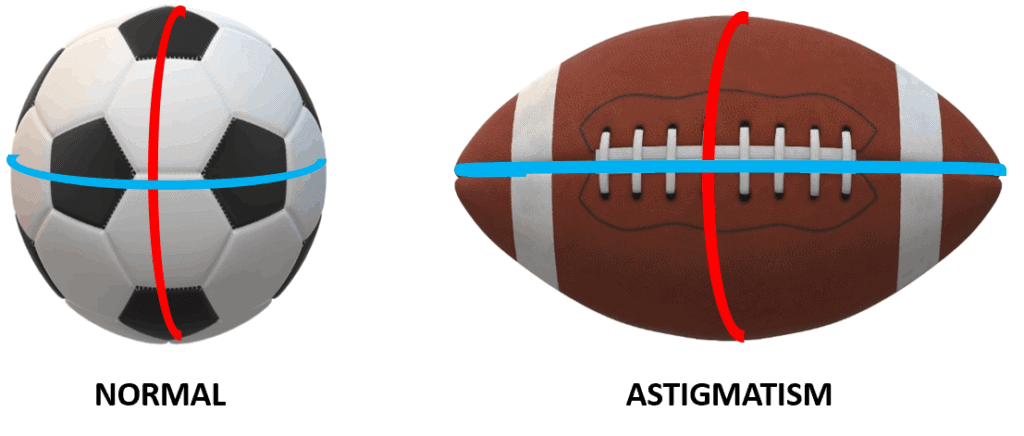
Taking the Stigma Out of Astigmatism
February 27, 2019

Everyone talks about having astigmatism, but don’t worry – it’s not an eye disease! Astigmatism is extremely common. So common that the majority of people have it to some degree, and chronic squinters can all agree that either glasses or contacts help alleviate the blur.
What is astigmatism?
Imagine the cornea (front surface of the eye) as a perfectly symmetrical sphere, similar to a soccer ball. There is no astigmatism present when the curvature in one direction (red line in picture) and that of another curve 90 degrees away (blue line in picture) are the exact same. However, if the curvature in one direction is “steeper” or different from the other, then astigmatism is present. Rather than the eye being a perfect sphere, there is irregular curvature on the front surface, making the eye appear more elongated in one direction, like a football. The lens inside the eye can also contribute to astigmatism if there is a cataract or an irregular shape.

Astigmatism is a form of refractive error. The three types of refractive error include astigmatism, myopia (nearsightedness), and hyperopia (farsightedness). Astigmatism is often associated in addition to myopia or hyperopia in an individual. The combination of these separate components results in a glasses or contact lens prescription. However, it is very possible to have a mild refractive error and not need any form of optical correction. The best way to determine if you need glasses or contacts is by having a full eye examination.
Why does astigmatism occur?
There isn’t a definitive cause of astigmatism, as it can be present from birth and fluctuate over time. Some forms of astigmatism can be the result of an irregularly shaped cornea from trauma, eye surgery, or a corneal condition, such as keratoconus. With keratoconus, the cornea gradually bulges forward in the shape of a protruding cone, which induces corneal astigmatism. Rigid gas permeable contacts usually provide the best vision for these people, however, vision can decrease as the condition progresses. If the cornea becomes too thin or damaged from keratoconus, a corneal transplant procedure is the next step.
Are there symptoms associated with astigmatism?
Squinting is the most common symptom associated with astigmatism. People with a mild amount of astigmatism may experience headaches, eye strain, and blurred vision with ocular fatigue towards the end of the day. The eyes can compensate and focus through a certain degree of blur, but after a long day of working on a computer, the eyes become tired and symptoms are more noticeable.
Moderate and severe amounts of astigmatism cause obvious blurred or distorted vision. Trying to focus through this type of astigmatism is nearly impossible.
How is astigmatism diagnosed? What is the treatment?
An optometrist is able to diagnose astigmatism based on the results of the refraction. During refraction, a phoropter (the big pair of glasses with all the dials and knobs) is used to determine a glasses prescription. When examining children, a retinoscope is used to reveal a prescription without any subjective responses from the child. If you or your child would benefit from glasses or contacts, you can trust that we’ll provide you with the best options to fit your individual situation.
Glasses, contact lenses, and LASIK are used to alleviate blurred vision caused from astigmatism. A glasses or contact lens prescription “corrects” the refractive error by balancing the corneal irregularity with lenses. Based on the severity of astigmatism, glasses may need to be worn all of the time or just during computer use and night driving.
On the other hand, LASIK truly corrects the refractive error by flattening and reshaping the cornea with a laser. While LASIK is an excellent option for some people, not all forms of astigmatism can be treated with LASIK.
Contrary to the contacts available years ago, there are soft contacts for people with astigmatism. Yes, you can wear contacts! “Toric” contact lenses correct for astigmatism and are commonly utilized. While they may take several minutes to settle into position on the eye, the majority of people have great success with wearing contacts.
So if you find yourself squinting throughout the day, feeling eyestrain after working on a computer, or noticing difficultly driving at night … come see us!